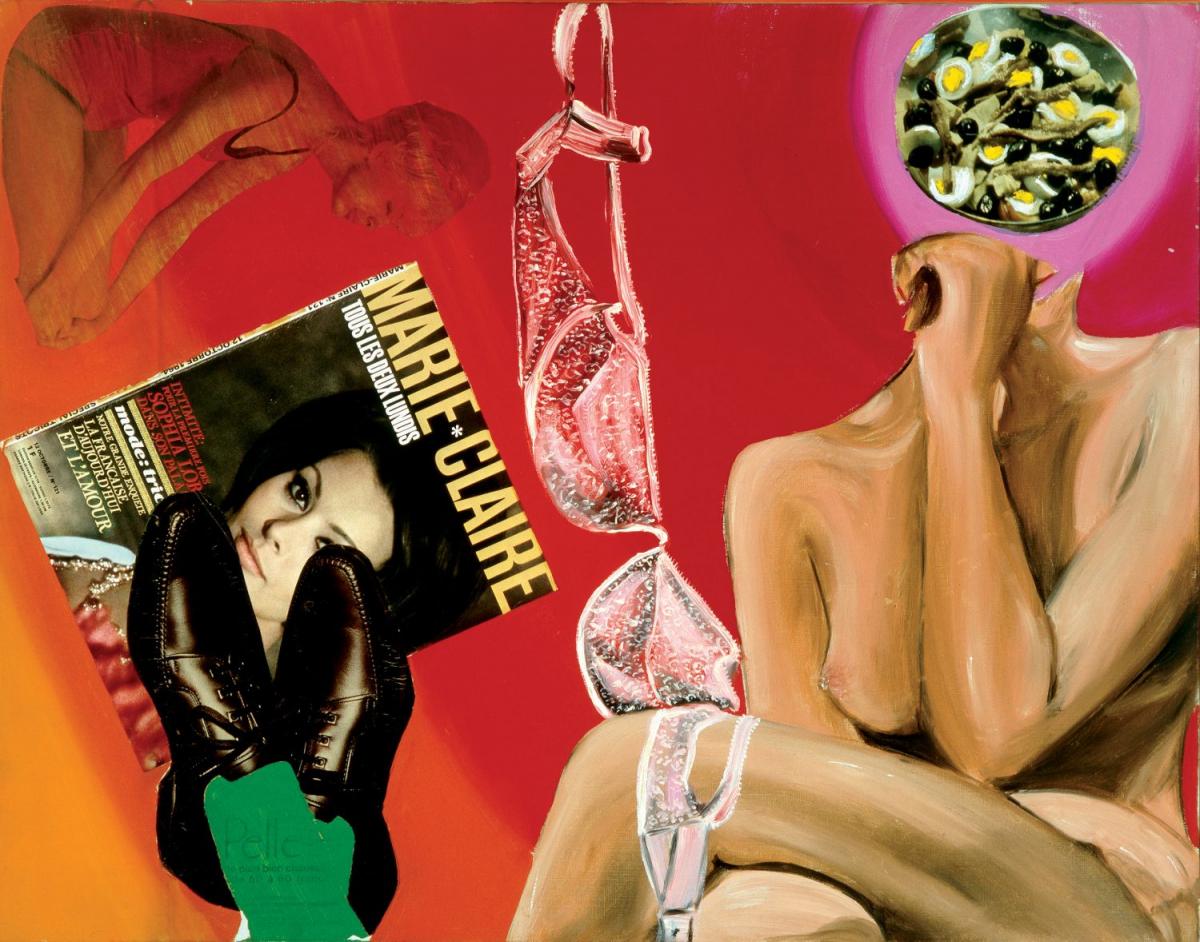Fantasies and Female Liberation
Created by Alexander Cesani on Sun, 04/07/2024 - 11:14
This timeline provides a sociohistorical context for Evelyn Axell's 1964 collage Marie-Claire.

Axell, Evelyne. Marie-Claire. 1964. ADAGP, Paris.https://awarewomenartists.com/en/artiste/evelyne-axell/. Accessed April 1, 2024.
Timeline
Chronological table
| Date | Event | Created by | Associated Places | |
|---|---|---|---|---|
| circa. 1960 to circa. 1980 |
Sexual RevolutionFor this instance, we’ll use the FDA approval of the daily pill contraceptive as the starting point for the sexual revolution. For the end date, we’ll use the year 1980 as the movement is often referred to in articles as “…of the 60s and 70s” The sexual revolution of the 1960s and 70s marked a period when women were taking control of their sexual lives for purposes other than procreation. This time saw women challenge conservative norms. Women were engaging in sexual relationships before marriages, they were dressing more provocatively, and media representations of women were becoming more sexually complex. The movement saw the promotion of the idea that women enjoy sex too. Sex could be for pleasure. Sex didn’t need to be tied to morality or religious dogma. This movement exposed the idea that virginity was a virtue to be a patriarchal construct used to objectify a woman and commodify her sexual experience. Women’s fashion during this time saw women choosing to wear shorter skirts and shorts. High-heeled boots were a popular choice of footwear, and the bikini swimsuit became a mainstay of women’s beach attire. Overall, the movement saw women retake the autonomy of their bodies. The 1960s: A Decade of Change for Women, www.usnews.com/news/articles/2010/03/12/the-1960s-a-decade-of-change-for.... Accessed 7 Apr. 2024. “A Timeline of Contraception.” PBS, Public Broadcasting Service, www.pbs.org/wgbh/americanexperience/features/pill-timeline/. Accessed 7 Apr. 2024. “The Pill and the Sexual Revolution.” PBS, Public Broadcasting Service, www.pbs.org/wgbh/americanexperience/features/pill-and-sexual-revolution/. Accessed 7 Apr. 2024. “Sexual Liberation and Sexual Revolutions.” Encyclopédie d’histoire Numérique de l’Europe, ehne.fr/en/encyclopedia/themes/gender-and-europe/demographic-transition-sexual-revolutions/sexual-liberation-and-sexual-revolutions#:~:text=Between%201960%20and%201980%2C%20sexual,from%20the%20institution%20of%20marriage. Accessed 7 Apr. 2024. |
Alexander Cesani | ||
| 9 Apr 1962 |
Sophia Loren Wins Her Historic Academy AwardIn the year 1961, Sophia Loren starred in the film La Ciociara (Two Women). Her performance in this role won her the 1961 Academy Award for Best Actress. This was the first Academy Award ever given to a performer for a non-English language film. This win garnered her international fame. Her roles were often women with complex sexual experiences. In La Ciociara, her character endures a sexual assault as she protects her daughter in post-invasion Italy. In later films, she would continue to take these complex roles as in her role in the 1964 film Matrimonio all’italiana (Marriage Italian Style). In this film, Loren portrays a post-War World II sex worker who mutually falls in love with a successful businessman. Loren wasn’t known just for her acting prowess, but for her beauty as well. She was an icon and sex symbol of the 60s. She appeared in Life magazine seven times through the 50s and 60s, Cosmopolitan and Vogue in 1962, the French women’s magazine Marie Claire in 1964, and countless other publications over the course of her career. Because of her beauty and the roles she took in films, she was often compared to Marilyn Monroe, often being called “The Italian Marilyn”. Thomas, Antonia. “Sophia Loren: The Story of the Most Iconic Italian Actress.” Italy Segreta, 11 Mar. 2024, italysegreta.com/sophia-loren-the-story-of-the-most-iconic-italian-actress/. “Two Women.” Wikipedia, Wikimedia Foundation, 9 Feb. 2024, en.wikipedia.org/wiki/Two_Women. Borrelli-Persson, Laird. “A ‘vogue’ Valentine to Sophia Loren, Star of ‘The Life Ahead,’ Her 98th Film.” Vogue, Vogue, 6 Nov. 2020, www.vogue.com/article/sophia-loren-from-the-vogue-archives. “Sophia Loren.” CBS News, CBS Interactive, 17 Dec. 2009, www.cbsnews.com/pictures/sophia-loren/4/.
|
Alexander Cesani | ||
| circa. 1964 |
Axell becomes a visual artistEvelyn Axell was born in 1935 in Namur, Belgium to a traditional catholic family. She attended a catholic school while she was growing up. This upbringing led her to have a lifelong distaste for conservative values and Christian morality. In 1953, Axell moved to Brussels to attend art school. She began her studies in ceramics before switching to acting. Going into the 1960s, Axell was on track for a promising acting career. She had steady work as a Television announcer and would have minor roles in film and theater productions. However, she found the work benign and dissatisfying. In 1964, Axell quit acting, and under the monitorship of Rene Magritte, began painting. She was Fascinated by the pop art scene of New York. She was one of the first European adapters of the style. Her works were often sexual or erotic depicting the nude female form and fantasy. Her early works are done mostly in oil paint, although she wouldn’t limit herself to a singular medium. Axell would explore the style of collage and the medium of enamels as well. It wouldn’t be until 1967 that she developed her signature technique of painting on plexiglass and other plastics. “Film: Evelyne Axell, Le Crocodile En Peluche.” WIELS, www.wiels.org/en/events/projection-de-film-evelyne-axell-le-crocodile-en.... Accessed 7 Apr. 2024. “Evelyne Axell.” AWARE Women Artists / Femmes Artistes, awarewomenartists.com/en/artiste/evelyne-axell/. Accessed 7 Apr. 2024. Tate. “Evelyne Axell.” Tate, www.tate.org.uk/whats-on/tate-modern/world-goes-pop/artist-biography/eve.... Accessed 7 Apr. 2024. “Evelyne Axell.” Widewalls, www.widewalls.ch/artists/evelyne-axell. Accessed 7 Apr. 2024.
This work is titled Marie-Claire and is a collage made by Evelyne Axell in 1964. The work features a nude faceless woman in a pensive pose. A sheer bra hangs through the center of the work with one end of the garment draped over the woman’s knee. Men’s shoes rise from the bottom border of the work and appear as if they are resting on a coffee table in a living room atop an issue of Marie-Claire. In the background, you see a woman in swimwear from the 1950s. The layers of paint that obscure her make her appear as if she is fading out. Evelyne Axell was a big supporter of the sexual revolution of the 1960s. She didn’t hold onto the idea that sex was only for procreation. She supported women finding fulfillment in their sexualities. Here, the depicted woman is nude maybe she just had sex with the man positioned off canvas, maybe she is a model. Her posture suggests that she is comfortable being naked in this context. Her legs are not crossed for modesty but rather to convey that she is thinking. Notice how one hand rests on her lap and the other strokes her chin like a philosopher lost in thought. Axelle is conveying the modern woman’s complexity of thought and comfort with sex through her in this image while the more modest woman in the background is fading. Moving from this imagined example to a real example of a woman we see Sophia Loren on the cover of Marie-Claire. Her appearance on Marie-Claire clues the viewer in on how iconic she is. She would be instantly recognizable to anyone who viewed this piece at the time. Loren would portray strong sexually complex women in her work. Axell is using her image to show how far the ideas of the sexual revolution and second-wave feminism have reached. Loren would depict realistic women in her work and in this work, she connects the viewer to the work. |
Alexander Cesani |



